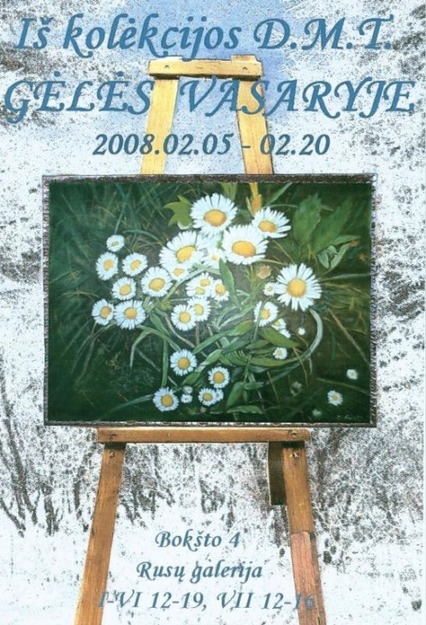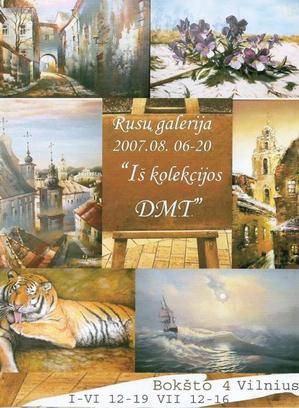For more information visit:
www.pier21.ca/support/wall-of-tribute
www.pier21.ca/support/wall-of-tribute
|
For more information visit:
www.pier21.ca/support/wall-of-tribute
0 Comments
IN MARCH 2008 YET ANOTHER EXHIBITION OF DMT COLLECTION WAS HELD IN RUSSIAN ART GALLERY. THE EXHIBITION WAS DEDICATED TO OUTER SPACE AND WAS DOMINATED BY LIONID LINDIN ARTWORKS OF COSMOS. THE UNUSUAL BEAUTY, QUALITY AND ATTENTION TO DETAIL SURPRISED THE AUDIENCE ATTRACTING A LOT OF VISITORS AND PUBLICITY. EXHIBITION WAS WIDELY PRAISED THROUGHOUT THE CAPITAL.
 DMT Collection Exhibition 2008 DMT Collection Exhibition 2008 FROM FEBRUARY 5 TO 20, 2008, A SECOND EXHIBITION WAS HELD AGAIN AT THE RUSSIAN ART GALLERY IN VILNIUS. THIS TIME THE EXHIBITION WAS STYLISTICALLY ORGANIZED AND HAD A VERY PRECISE THEME. IT WAS NAMED “FLOWERS IN FEBRUARY” AND THE ENTIRE EXPOSITION WAS DEDICATED TO THE BEAUTIFUL WILD FLOWERS OF LITHUANIA. "OVER THE PAST TWO YEARS I HAVE USED MY CAMERA TO CAPTURE AT CLOSE RANGE AND HIGH DEFINITION WILD FLOWERS THAT NATURALLY GROW ALL AROUND US AND INVITED LOCAL ARTISTS TO RECREATE THOSE IMAGES WITH OIL ON CANVAS." ALL THE ARTWORKS WERE THEN FRAMED WITH MUSEUM-QUALITY FRAMES AND PRESENTED TO THE PUBLIC FOR THE FIRST TIME IN THIS EXHIBITION. THE RESULTS WERE FANTASTIC: OVER SEVEN HUNDRED VISITORS IN TWO WEEKS. ARTICLES WERE PUBLISHED IN THE TWO MOST-READ NEWSPAPERS IN LITHUANIA, “THE WEEKLY EXPRESS” AND “LITHUANIAN COURIER”. AN INTERVIEW WAS BROADCAST ON THE LITHUANIAN RADIO RUSSIAN CHANEL (102.6 FM). COUNTLESS NOTICES WERE PUBLISHED ON THE INTERNET, INCLUDING THE MOST INFORMATIVE WEBSITE IN LITHUANIA, “ANONSAS.LT”. THE WONDERFUL FEEDBACK WE RECEIVED MADE IT A TRULY POSITIVE EXPERIENCE. IT SHOULD BE MENTIONED THAT THE EXHIBITION WE HELD WAS THE FIRST OF ITS KIND IN LITHUANIA AND EASTERN EUROPE. NEVER BEFORE HAVE SUCH SMALL AND COMMON FLOWERS BEEN PRESENTED AT SUCH CLOSE RANGE, IN SUCH SIZE AND DETAIL, AT LEAST IN LITHUANIA. FROM THE REACTION OF THE VIEWING PUBLIC IT SEEMS NO EXHIBITION WITH THIS THEME WAS EVER DONE ON THE ENTIRE EUROPEAN CONTINENT. Lithuanian Courier – Litovsky Kurier № 6 (676) February 7-13 2008 February 6 – February 20 at the Russian Gallery in Vilnius, Lithuania the exhibition “Flowers in February” presented DMT collection. Last year the Russian Gallery displayed a substantial part of his collection. This time the entire exhibition is devoted to flowers. Here you can see the still life of Leonid Lindin, reminiscent of artworks by Ivan Hrutski, the Russian 19th -century painter, as well as pictures of common wild flowers – daisies, cornflowers, wild chicories, meadow-sweetsand others – created by Alexander Lysiuk, Igor Latishev and Gintas Markyavichus. The idea of creating such paintings was Mr. Tamoikin’s, whose work and lifestyle require quite a bit of travel. “It seems”, Mr. Tamoikin says, “that it would be impossible to understand another country’s soul during a short visit. But that’s not so. By visiting art galleries, exhibitions, museums, and markets, surprisingly soon you start to understand the culture and spirit of that country. It inspired me to create a collection of Lithuanian art, represented by different artists in a variety of works and aspects.” Mr. Tamoikin values Lithuanian artists very highly. Exhibition review by Liudmila Buchneva
Director of the Lithuanian Public Institution “ Meno Iniciatyva – Art Initiative” An exhibition of paintings took place at Vilnius Russian Gallery from February 5 to 20. It was already the second acquaintance of the public with DMT collection within the precincts of the Russian Gallery. This time the title of the exhibition was “Flowers in February”, as it was entirely dedicated to flowers. The paintings of Igor Latysev prevailed in the exhibition. He did more than thirty “portraits” of common field flowers, such as a sweet pea, tansy, corn flowers, daisies, meadow-sweet, etc. and also inflorescences of some widely-distributed shrubs, 27 species of which were represented in the exhibition. The same theme was observed in two paintings of Aleksandr Lysiuk, who depicted a wild geranium and chicory. Judging from the reaction of the spectators, the exhibition aroused great interest and the idea appeared to be of rare success. The paintings were admired, and the visitors dreamed of acquiring something of the kind. Indeed, these creations sang as a hymn to the nature, and the beauty of each plant made everybody look in new light at such a familiar and wonderful image. While it might seem that the task put before the artists was not very complicated, no doubt the skill of an artisan was necessary, and happily it did exist. It is difficult to find fault with the paintings of Latysev and Lysiuk displayed in the exhibition and there is no wish to do so – they are convincing, the expression of the works is in full harmony with their topic. …Quite peculiar seemed the still life by Leonid Lindin, under the whimsical title “Fantasy of Your Girlfriend”. Lindin could be considered a follower of the naturalistic school of painting; his still lives are a direct and convincing continuation of that school. He is most close to the 19th-century Russian painter Ivan Khrutsky: the same language of expression, the same type of composition (as a rule, central), the same love for bouquets of flowers and butterflies. However, Lindin puts a butterfly not only on a flower in the painting but also on the frame, referencing the illusions so loved in Europe in the 16th and 17th centuries and Russia in the 18th century. By asking “whether art is an illusion” it is possible to question the aesthetic value of naturalism as a whole. Nevertheless, the work shows that neither the followers of this trend nor its admirers grow fewer. The exhibition proved this: The work of Lindin attracted great attention and evoked endless delight. In general, the exhibition has demonstrated that there are quite a number of artists of the naturalistic school in Lithuania and there is a demand for works of this kind among art-lovers. Time will show whether it will contribute to an increase in the number of followers of this trend among artists. Vilnius , February 2008  DMT Collection Exhibition 2007 DMT Collection Exhibition 2007 THE FIRST ART EXHIBITION WAS HELD ON AUGUST 6, 2007. IT WAS NAMED “ART FROM D.M.T. COLLECTION”, SHOWING A RELATIVELY SMALL PORTION OF COLLECTED ARTWORKS. ONLY 44 PAINTINGS WERE PRESENTED IN THE RUSSIAN ART GALLERY LOCATED IN THE OLD TOWN OF VILNIUS. THE EXHIBITION CONTINUED FOR TWO WEEKS AND WAS A CONSIDERABLE SUCCESS, WITH MORE THAN 420 VISITORS. IT WAS SHOWN ON NATIONAL TELEVISION ON AUGUST 6 ON LITHUANIAN NEWS. ALL MAJOR RADIO REPORTERS WERE PRESENT AT THE EXHIBITION, INCLUDING LITHUANIAN RADIO AND RUSSIAN RADIO – LITHUANIA. OUR INTERVIEW WITH THEM WAS BROADCASTED ON AUGUST 6 AND 7 IN TWO LANGUAGES: RUSSIAN AND LITHUANIAN. Exhibition review by Liudmila Buchneva Director of the Lithuanian Public Institution “ Meno Iniciatyva – Art Initiative” At the end of the summer of 2007 an exhibition took place in Vilnius Russian Art Gallery in which a number of paintings from the DMT collection were displayed. First of all, let us make an observation: for the organizers of this exhibition, the term “Lithuanian Art” meant one thing: the art of creative painters of the state of Lithuania, regardless of their ethnic belonging. Actually, it is and has always been as follows: geniuses and talents of most different blood are intertwined in each culture: the Russians have Pushkin, Levitan, Repin… The list of examples may be continued and continued.The exhibition aroused great interest and information about it was twice shown on Lithuanian TV channels. It was visited by a large number of people, the majority of whom made enthusiastic comments. This interest is understandable as the DMT collection is unique already by its very intention. The organizer made an attempt to present that modern art of Lithuania which is well-known to the broadest circle of spectators, demanded and loved by it. We may say that the DMT collection (in the version it exists in at the moment) is a mirror of today’s Lithuanian society: It precisely fixes the society’s aesthetic and thematic preferences. Having cast a glance on the exhibition as a whole, I want to say one thing: how wonderful that such a collection exists. Whatever the road the collector would take further on; the DMT collection will be of interest not only for the buyers, spectators and art critics but also for sociologists and historians of culture. Vilnius, September 2007 |
DMT
|
